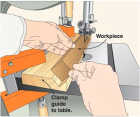I have a Rikon 10-306 10" bandsaw, and I'm looking for either some tips, tricks, or YouTube videos for cutting the corners off of turning blank; not a flat bowl blank, but a longer narrower blank. For example a 3" x 3" x 6" blank. If it's a wood blank, I normally just round it off on the lathe as normal, but as I do more and more resin/wood blanks, I figured it'd save on the tool wear & tear and even lathe wear & tear if I trimmed the corners off to get more of an octagon.
I also suppose using the table saw, with the blade at 45 degrees should accomplish the same thing, no?
I also suppose using the table saw, with the blade at 45 degrees should accomplish the same thing, no?

